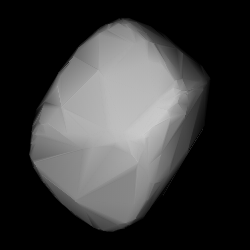
Tirza is a fairly sizeable, very dark Main belt asteroid.

Elvira is a typical main belt asteroid and is a member of the Koronis asteroid family. It was discovered by Auguste Charlois on 3 May 1888 in Nice. (277) Elvira is possibly named for a character in Alphonse de Lamartine's Méditations poétiques (1820) and Harmonies poétiques et religieuses (1830).

Clorinde is a typical Main belt asteroid. It was discovered by Auguste Charlois on 28 January 1889 in Nice. It was named after Clorinda, the heroine of Torquato Tasso's poem Jerusalem Delivered.

Caecilia is a typical main belt asteroid. It was discovered by Auguste Charlois on 9 September 1890 in Nice.

Geraldina is a large Main belt asteroid. It was discovered by Auguste Charlois on October 3, 1890, in Nice. The origin of the name is unknown. It is orbiting the Sun at a distance of 3.21 AU with a period of 5.74 yr and an eccentricity (ovalness) of 0.057. The orbital plane is tilted at an angle of 0.73° to the plane of the ecliptic.

Claudia is a typical Main belt asteroid.

Rosalia is a large Main belt asteroid. It was discovered by Auguste Charlois on 1 September 1891 in Nice.

Etheridgea is a large main belt asteroid. It was discovered by Auguste Charlois on 1 April 1892 in Nice. The meaning of the name is unknown. This asteroid is orbiting the Sun at a distance of 3.02 AU with a period of 5.26 years and an eccentricity (ovalness) of 0.10. The orbital plane is tilted at an angle of 6.05° to the plane of the ecliptic.

Apolonia is a large Main belt asteroid. It was discovered by Auguste Charlois on 8 March 1893 in Nice.

Georgia is a typical Main belt asteroid. It is classified as an X-type asteroid.

Corduba is a very large main-belt asteroid that was discovered by the French astronomer Auguste Charlois on 21 March 1893 from Nice. It is classified as a C-type asteroid and is probably composed of carbonaceous material.

Campania is a large main belt asteroid that was discovered by French astronomer Auguste Charlois on 20 September 1893 in Nice.

380 Fiducia is a dark and large asteroid, approximately 68 kilometers in diameter, located in the central region of the asteroid belt. It was discovered by French astronomer Auguste Charlois at the Nice Observatory on 8 January 1894. The carbonaceous C-type asteroid has a rotation period of 13.7 hours. It was named "Fiducia", the Latin word for confidence.

Delia is a large Main belt asteroid. It was discovered by the French astronomer Auguste Charlois on 30 November 1894 in Nice. "Delia" is an epithet for the ancient Greco-Roman Moon goddess Artemis, for her birthplace at Delos. This asteroid is orbiting the Sun at a distance of 2.79 AU with an orbital eccentricity (ovalness) of 0.085 and a period of 4.64 yr. The orbital plane is tilted at an angle of 3.35° to the plane of the ecliptic.

Ducrosa is a typical Main belt asteroid. It was discovered by Auguste Charlois on 15 March 1895 in Nice.

402 Chloë is a large main-belt asteroid. It was discovered by French astronomer Auguste Charlois on 21 March 1895 from Nice. This asteroid is orbiting the Sun at a distance of 2.56 AU with a period of 4.09 years and an eccentricity of 0.11. The orbital plane is inclined at an angle of 11.8° to the plane of the ecliptic.
Xanthe, minor planet designation 411 Xanthe, is an asteroid from the outer regions of the asteroid belt, approximately 77 kilometers in diameter. It was discovered by French astronomer Auguste Charlois at Nice Observatory on 7 January 1896. The asteroid was named after Xanthe, an Oceanid or sea nymph, and one of the many Titan daughters of Oceanus and Tethys from Greek mythology.
Gratia is a large Main belt asteroid.

Galene is a typical main belt asteroid. It was discovered by the French astronomer Auguste Charlois on 27 August 1897 from Nice, and was named after Galene, one of the Nereids of Greek Mythology. This asteroid is orbiting the Sun at a distance of 2.97 AU with a period of 5.12 yr and an eccentricity of 0.12. A computer search suggests it is the most likely parent body of the impactor that generated the temporary cometary activity of 7968 Elst–Pizarro in 1996.

1510 Charlois, provisional designation 1939 DC, is a carbonaceous Eunomia asteroid from the middle region of the asteroid belt, approximately 24 kilometers in diameter.


















